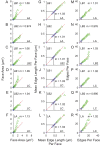Structural organization of nuclear lamins A, C, B1, and B2 revealed by superresolution microscopy
- PMID: 26310440
- PMCID: PMC4710238
- DOI: 10.1091/mbc.E15-07-0461
Structural organization of nuclear lamins A, C, B1, and B2 revealed by superresolution microscopy
Abstract
The nuclear lamina is a key structural element of the metazoan nucleus. However, the structural organization of the major proteins composing the lamina is poorly defined. Using three-dimensional structured illumination microscopy and computational image analysis, we characterized the supramolecular structures of lamin A, C, B1, and B2 in mouse embryo fibroblast nuclei. Each isoform forms a distinct fiber meshwork, with comparable physical characteristics with respect to mesh edge length, mesh face area and shape, and edge connectivity to form faces. Some differences were found in face areas among isoforms due to variation in the edge lengths and number of edges per face, suggesting that each meshwork has somewhat unique assembly characteristics. In fibroblasts null for the expression of either lamins A/C or lamin B1, the remaining lamin meshworks are altered compared with the lamin meshworks in wild-type nuclei or nuclei lacking lamin B2. Nuclei lacking LA/C exhibit slightly enlarged meshwork faces and some shape changes, whereas LB1-deficient nuclei exhibit primarily a substantial increase in face area. These studies demonstrate that individual lamin isoforms assemble into complex networks within the nuclear lamina and that A- and B-type lamins have distinct roles in maintaining the organization of the nuclear lamina.
© 2015 Shimi, Kittisopikul, et al. This article is distributed by The American Society for Cell Biology under license from the author(s). Two months after publication it is available to the public under an Attribution–Noncommercial–Share Alike 3.0 Unported Creative Commons License (http://creativecommons.org/licenses/by-nc-sa/3.0).
Figures





Similar articles
-
The molecular architecture of lamins in somatic cells.Nature. 2017 Mar 9;543(7644):261-264. doi: 10.1038/nature21382. Epub 2017 Mar 1. Nature. 2017. PMID: 28241138 Free PMC article.
-
Nuclear envelope remodelling during human spermiogenesis involves somatic B-type lamins and a spermatid-specific B3 lamin isoform.Mol Hum Reprod. 2015 Mar;21(3):225-36. doi: 10.1093/molehr/gau111. Epub 2014 Dec 4. Mol Hum Reprod. 2015. PMID: 25477337
-
Lamins: The backbone of the nucleocytoskeleton interface.Curr Opin Cell Biol. 2024 Feb;86:102313. doi: 10.1016/j.ceb.2023.102313. Epub 2024 Jan 22. Curr Opin Cell Biol. 2024. PMID: 38262116 Review.
-
Concentric organization of A- and B-type lamins predicts their distinct roles in the spatial organization and stability of the nuclear lamina.Proc Natl Acad Sci U S A. 2019 Mar 5;116(10):4307-4315. doi: 10.1073/pnas.1810070116. Epub 2019 Feb 14. Proc Natl Acad Sci U S A. 2019. PMID: 30765529 Free PMC article.
-
Quantitative Analysis of Nuclear Lamins Imaged by Super-Resolution Light Microscopy.Cells. 2019 Apr 18;8(4):361. doi: 10.3390/cells8040361. Cells. 2019. PMID: 31003483 Free PMC article. Review.
Cited by
-
Effects of mutant lamins on nucleo-cytoskeletal coupling in Drosophila models of LMNA muscular dystrophy.Front Cell Dev Biol. 2022 Aug 31;10:934586. doi: 10.3389/fcell.2022.934586. eCollection 2022. Front Cell Dev Biol. 2022. PMID: 36120560 Free PMC article.
-
Nuclear poly-glutamine aggregates rupture the nuclear envelope and hinder its repair.J Cell Biol. 2024 Nov 4;223(11):e202307142. doi: 10.1083/jcb.202307142. Epub 2024 Aug 16. J Cell Biol. 2024. PMID: 39150509 Free PMC article.
-
Super-Resolution Imaging of the A- and B-Type Lamin Networks: A Comparative Study of Different Fluorescence Labeling Procedures.Int J Mol Sci. 2021 Sep 22;22(19):10194. doi: 10.3390/ijms221910194. Int J Mol Sci. 2021. PMID: 34638534 Free PMC article.
-
Design of a microfluidic device to quantify dynamic intra-nuclear deformation during cell migration through confining environments.Integr Biol (Camb). 2015 Dec;7(12):1534-46. doi: 10.1039/c5ib00200a. Epub 2015 Nov 9. Integr Biol (Camb). 2015. PMID: 26549481 Free PMC article.
-
Computational analyses reveal spatial relationships between nuclear pore complexes and specific lamins.J Cell Biol. 2021 Apr 5;220(4):e202007082. doi: 10.1083/jcb.202007082. J Cell Biol. 2021. PMID: 33570570 Free PMC article.
References
-
- Aebi U, Cohn J, Buhle L, Gerace L. The nuclear lamina is a meshwork of intermediate-type filaments. Nature. 1986;323:560–564. - PubMed
-
- Ben-Harush K, Wiesel N, Frenkiel-Krispin D, Moeller D, Soreq E, Aebi U, Herrmann H, Gruenbaum Y, Medalia O. The supramolecular organization of the C. elegans nuclear lamin filament. J Mol Biol. 2009;386:1392–1402. - PubMed
-
- Bresenham JE. Algorithm for computer control of a digital plotter. IBM Syst J. 1965;4:25–30.
Publication types
MeSH terms
Substances
Grants and funding
LinkOut - more resources
Full Text Sources
Other Literature Sources
Research Materials

